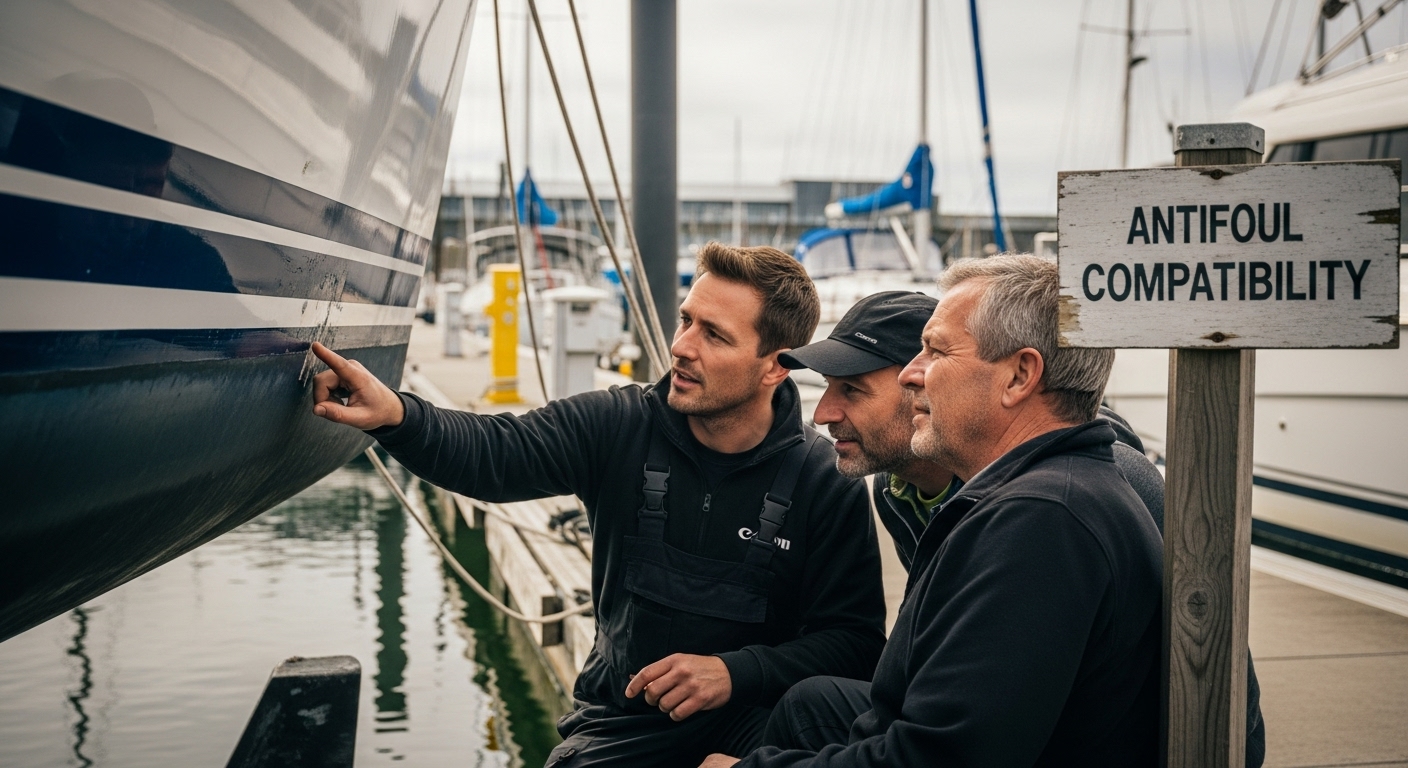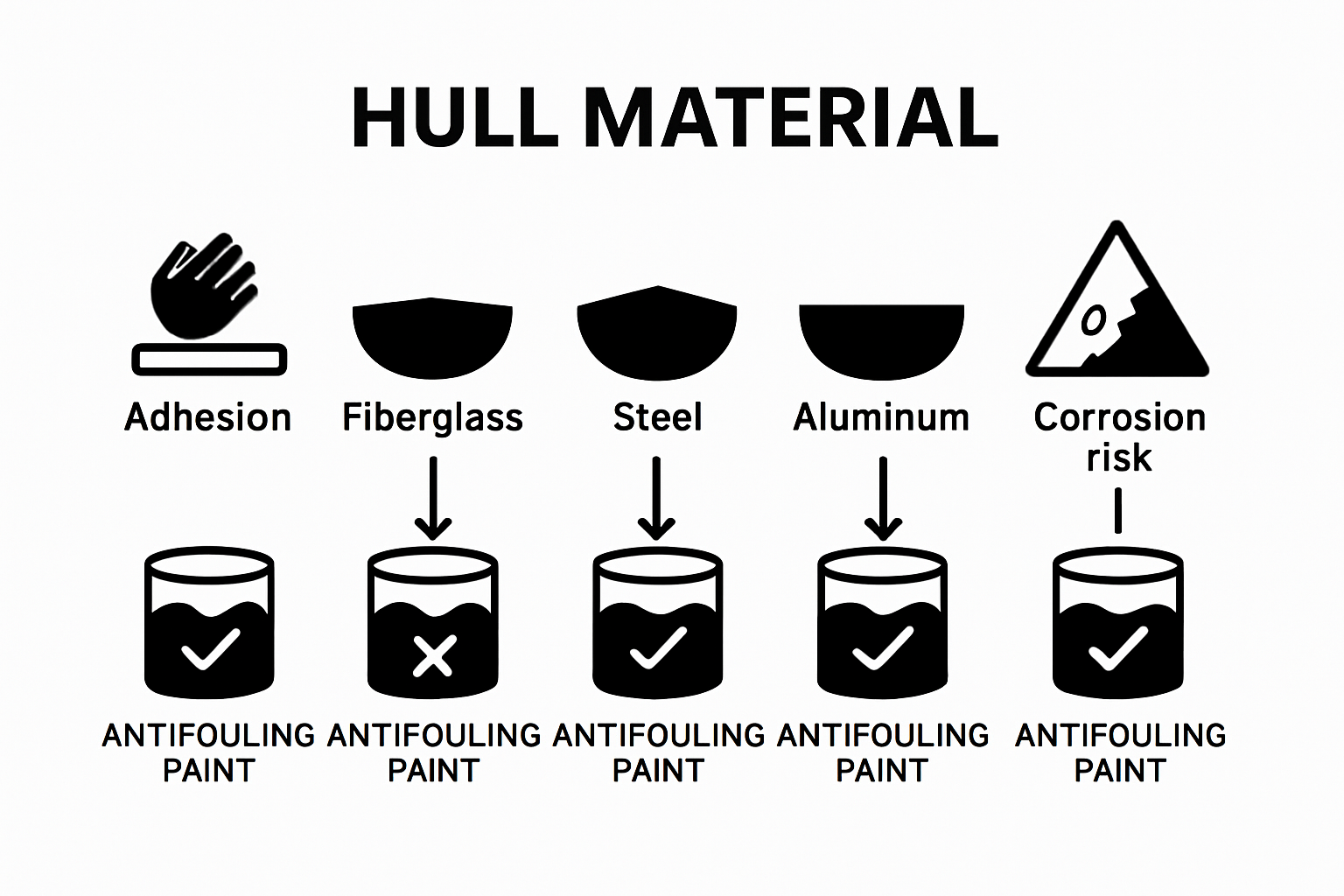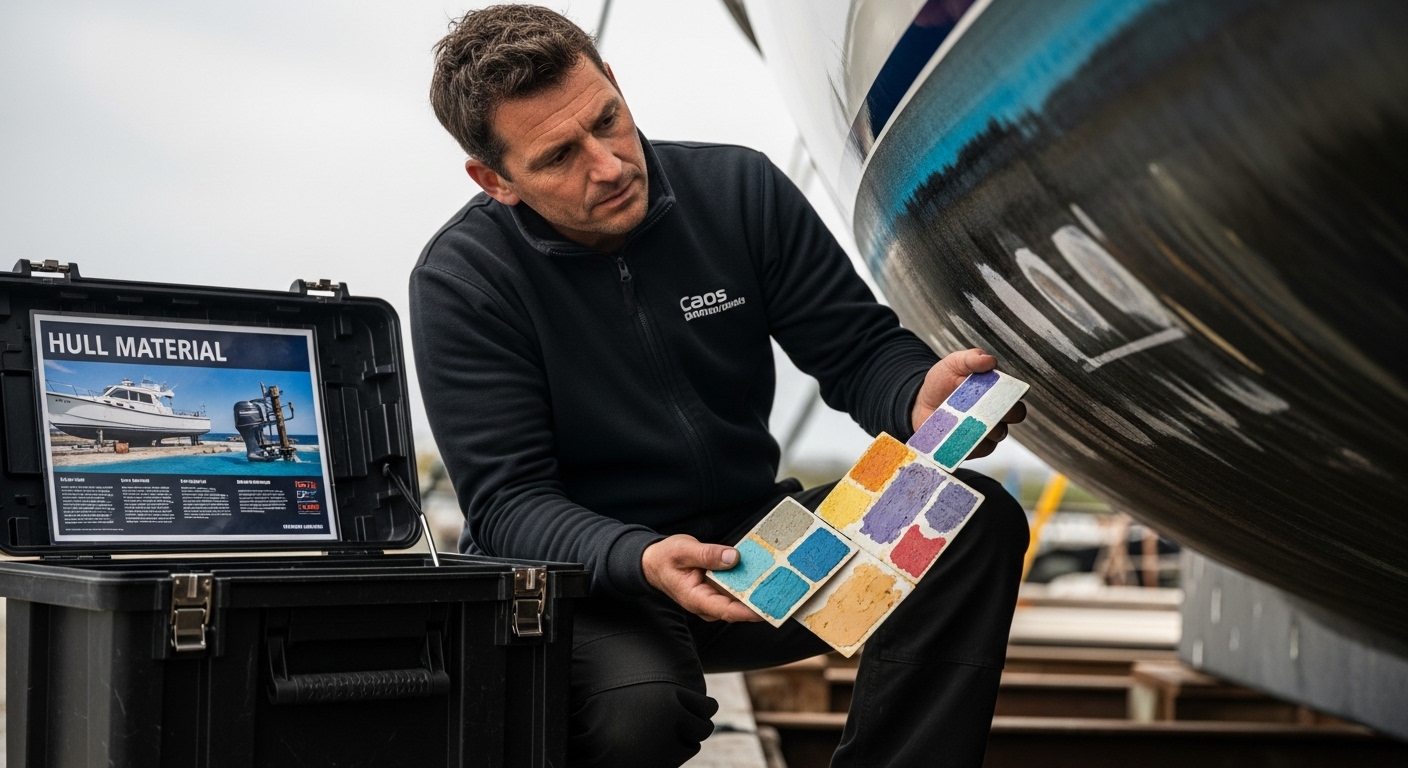Understanding What is Antifoul Compatibility for Boats
- andy80165
- Sep 12
- 8 min read

Picking the right antifoul for your boat is not just a chore. It can decide how smoothly your vessel slices through the water and even how much money you spend fixing problems later. Many assume any antifouling paint will do the job. Surprisingly, the wrong match can hike your fuel use and destroy your hull’s protection in just one season. The real secret is that antifoul compatibility is less about picking a strong paint and more about choosing the solution that fits your exact hull, water type, and legal limits. That changes everything.
Table of Contents
Quick Summary
What is Antifoul Compatibility and Why It Matters
Antifoul compatibility represents a critical consideration for boat owners seeking to protect their vessels from marine growth and potential damage. This complex process involves selecting an appropriate antifouling solution that matches your specific boat surface, environmental conditions, and regulatory requirements.
Understanding Antifoul Compatibility Basics
Antifoul compatibility refers to the chemical and physical suitability of an antifouling paint or coating with your boat’s existing surface material. Not all antifoul products work effectively on every boat hull or substrate. Different boat materials like fiberglass, aluminum, wood, and steel require specific antifouling formulations to ensure proper adhesion, protection, and performance.
To help clarify the specific requirements for different boat hull materials, the following table summarizes compatible antifouling formulations and key compatibility considerations for each material type:
Key factors determining antifoul compatibility include:
Hull material composition
Previous coating layers
Water salinity and temperature
Typical vessel usage patterns
Local marine environmental regulations
Environmental and Regulatory Considerations
Antifoul compatibility extends beyond technical performance. According to the Australian Department of Infrastructure, Transport, Regional Development, environmental regulations now strictly control the chemical composition of antifouling paints. Boat owners must select products that not only protect their vessel but also minimize ecological impact.
Performance and Long Term Protection
Proper antifoul compatibility ensures optimal vessel performance, reduced marine growth, and extended maintenance intervals. Incompatible antifouling solutions can lead to premature coating failure, increased fuel consumption, and potential damage to the boat’s underlying structure.
This table organizes the main negative outcomes that can result from poor antifoul compatibility, highlighting the risks involved and their impact on boat maintenance and performance:
Check out our guide on how to choose antifoul for more detailed insights into selecting the right product for your specific boat requirements.
Ultimately, understanding antifoul compatibility is not just about protecting your boat it is about making an informed decision that balances technical performance, environmental responsibility, and long term vessel maintenance.
The Role of Antifouling Paints in Boat Maintenance
Antifouling paints play a critical role in protecting boats from marine organisms that can significantly impact vessel performance, efficiency, and structural integrity. These specialized coatings serve as a fundamental defense mechanism against biological fouling in marine environments.
Preventing Marine Growth and Biological Attachment
Marine organisms like algae, barnacles, and mollusks naturally seek to attach themselves to boat hulls, creating complex biological ecosystems that can dramatically increase drag and reduce vessel efficiency. Antifouling paints work by releasing biocidal compounds that prevent these organisms from establishing permanent attachment, thereby maintaining the boat’s hydrodynamic performance.
Key protective mechanisms of antifouling paints include:
Creating a toxic surface that deters marine organism settlement
Gradually releasing biocidal compounds to maintain protection
Forming a barrier between the hull and potential biological invaders
Reducing ongoing maintenance requirements
Environmental and Performance Considerations
According to the Western Australia Department of Transport, effective antifouling paint application is crucial for maintaining vessel performance and protecting marine ecosystems. Modern antifouling technologies focus on minimizing ecological impact while providing robust protection against marine growth.
Long Term Vessel Protection Strategy
Antifouling paints represent more than just a surface treatment they are a comprehensive approach to vessel maintenance. By preventing marine organism attachment, these specialized coatings help boat owners reduce fuel consumption, maintain optimal speed, and extend the overall lifespan of their vessels. Learn more about our comprehensive antifouling lifecycle approach to understand how strategic coating management can protect your marine investment.
Ultimately, antifouling paints are an essential investment in maintaining a boat’s performance, efficiency, and long term structural integrity, providing boat owners with a critical defense against the challenging marine environment.
How Antifoul Compatibility Affects Boat Performance
Antifoul compatibility directly influences a boat’s performance through complex interactions between the hull surface, coating materials, and marine environment. Understanding these dynamics helps boat owners optimize vessel efficiency and minimize potential performance degradation.
Hydrodynamic Impact of Incompatible Coatings
Incompatible antifouling solutions can create surface irregularities that dramatically increase hull drag and reduce overall vessel performance. When an antifouling paint fails to properly adhere or interact with the boat’s substrate, it can create microscopic imperfections that disrupt water flow and increase resistance.
Key performance considerations include:
Increased fuel consumption due to heightened hydrodynamic friction
Reduced maximum speed capabilities
Potential premature coating breakdown
Compromised vessel maneuverability
Higher long term maintenance costs
Biological Growth and Efficiency Reduction
According to the Department of Agriculture, Fisheries and Forestry, biofouling can significantly impact vessel performance. Antifoul compatibility determines how effectively a coating prevents marine organism attachment, which directly correlates with maintaining optimal hydrodynamic efficiency.
Long Term Performance Optimization
Proper antifoul compatibility is not just about immediate performance but represents a strategic approach to vessel maintenance. Check out our specialized boat antifoul services to understand how professional coating selection can transform your boat’s long term performance potential.
Ultimately, selecting a compatible antifouling solution means investing in your boat’s ongoing efficiency, reducing operational costs, and ensuring consistent marine performance across varying environmental conditions.
Key Factors Influencing Antifoul Compatibility
Antifoul compatibility represents a sophisticated interplay between multiple technical and environmental variables that determine the effectiveness of marine coatings. Understanding these critical factors helps boat owners make informed decisions about protecting their vessels from marine growth and potential performance degradation.
Hull Material and Surface Composition
The foundational element of antifoul compatibility begins with the boat’s underlying surface material. Different hull substrates such as fiberglass, aluminum, wood, and steel require specialized antifouling formulations that chemically and physically bond without causing structural compromise. Each material presents unique challenges in terms of coating adhesion, thermal expansion, and corrosion resistance.
Critical surface characteristics affecting compatibility include:

Surface porosity and texture
Existing coating layers
Chemical reactivity of substrate material
Surface preparation and cleanliness
Potential for galvanic corrosion
Environmental Interaction and Performance Parameters
According to the Australian Department of Infrastructure, Transport, Regional Development, environmental regulations now mandate strict considerations for antifouling compatibility. Boat owners must evaluate multiple performance parameters beyond simple marine growth prevention, including water salinity, temperature ranges, and specific marine ecosystem interactions.
Maintenance and Long Term Durability
Antifoul compatibility extends far beyond initial application, encompassing long term durability and maintenance requirements. Learn essential boat bottom cleaning tips to understand how proper maintenance directly impacts coating performance and vessel efficiency.
Ultimately, successful antifoul compatibility demands a holistic approach that considers technical, environmental, and operational factors, ensuring optimal protection and performance for marine vessels across diverse conditions.

Real-World Examples of Antifoul Compatibility Issues
Antifoul compatibility challenges manifest in various practical scenarios, revealing the complex interactions between marine coatings, vessel substrates, and environmental conditions. Understanding these real-world examples helps boat owners anticipate and prevent potential performance and maintenance complications.
Substrate Interaction and Coating Failure
One critical compatibility issue emerges when antifouling paints fail to properly adhere to specific hull materials. For instance, applying a copper-based antifouling coating on an aluminum hull can trigger galvanic corrosion, rapidly degrading the vessel’s structural integrity. This chemical incompatibility can lead to unexpected maintenance expenses and significant performance reduction.
Common substrate compatibility challenges include:
Premature coating breakdown
Accelerated metal corrosion
Uneven paint distribution
Reduced protective capabilities
Increased vessel maintenance costs
Environmental Performance Degradation
According to the International Convention on the Control of Harmful Anti-fouling Systems, environmental regulations now strictly monitor antifouling systems. Real-world examples demonstrate how incompatible coatings can lead to unexpected ecological impacts, including excessive biocide leaching and marine ecosystem disruption.
Practical Maintenance and Performance Implications
Boat owners frequently encounter compatibility issues that directly impact vessel performance. Explore our comprehensive antifoul and propeller services to understand how professional assessment can mitigate these complex technical challenges.
Ultimately, real-world antifoul compatibility issues underscore the importance of meticulous coating selection, professional application, and ongoing maintenance to ensure optimal marine vessel performance and longevity.
Experience the Difference of Expert Antifoul Compatibility Services
Are you worried about choosing the right antifouling solution for your boat and avoiding performance problems caused by poor compatibility? Many boat owners struggle with coating failures, increased maintenance costs, and even hull damage when the wrong antifoul is applied. The article highlighted how critical proper antifoul compatibility is in protecting your vessel and keeping it running efficiently.

Let us give you peace of mind. At Lightning Boat Builders, our mobile marine team specializes in matching the best antifoul to your specific hull and environment. We handle every detail so you avoid the pain of premature wear and costly repairs. Discover how our custom antifouling and maintenance services can protect your investment for the long haul. Act now for expert support that keeps your boat performing at its peak. Book your consultation today through our website.
Frequently Asked Questions
What is antifoul compatibility?
Antifoul compatibility refers to the suitability of an antifouling paint or coating with your boat’s existing surface material. It ensures that the antifouling product adheres properly and performs effectively according to the specific hull material, environmental conditions, and regulatory requirements.
Why is antifoul compatibility important for boat maintenance?
Antifoul compatibility is crucial as it affects your boat’s performance, helps prevent marine growth, and extends maintenance intervals. Incompatible antifouling solutions can lead to issues such as premature coating failure, increased fuel consumption, and damage to the boat’s structure.
How can I determine if an antifouling product is compatible with my boat’s hull material?
To determine antifoul compatibility, consider your boat’s hull material (fiberglass, aluminum, wood, or steel), any existing paints, and conditions such as water salinity and usage patterns. Consulting with professionals or checking product specifications is recommended for proper guidance.
What are the potential consequences of using an incompatible antifouling paint?
Using an incompatible antifouling paint can lead to increased drag and fuel consumption, reduced performance capabilities, premature coating breakdown, and the need for more frequent maintenance. This could ultimately compromise the boat’s efficiency and result in higher long-term costs.
Recommended
Comments